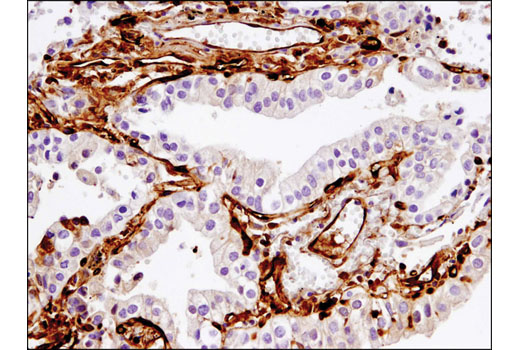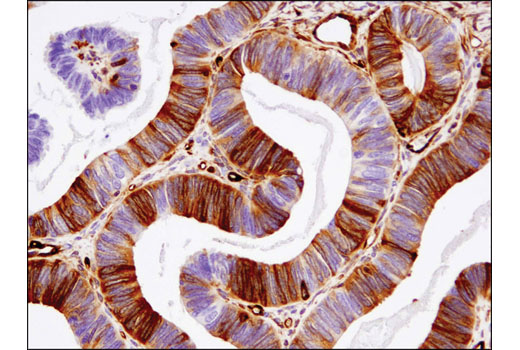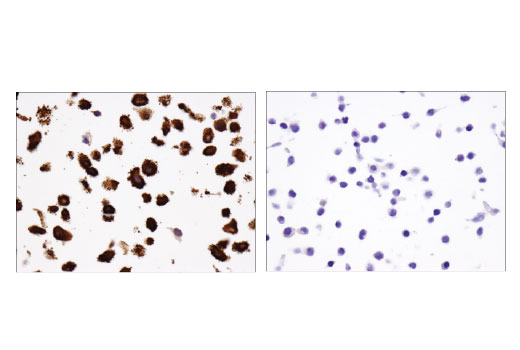IHC-P
H M
Endogenous
Mouse IgG1
#Q16658
6624
Product Information
Product Usage Information
| Application | Dilution |
|---|---|
| Immunohistochemistry (Paraffin) | 1:100 |
Storage
Specificity / Sensitivity
Species Reactivity:
Human, Mouse
Source / Purification
Monoclonal antibody is produced by immunizing animals with fascin protein purified from HeLa cells.
Background
Fascin is a monomeric, globular protein that plays a central role in regulating the structure and function of the cortical actin cytoskeleton (1). Fascin promotes cross-linkage of parallel actin filaments during the formation of cell protrusions (lamellipodia and filopodia), and therefore plays an important role in regulating cell migration (2). It has been reported that fascin may also regulate filopodia formation by a mechanism independent of its actin-bundling functions (3), though less is known about this mechanism of action. Research studies have shown that increased fascin expression is associated with increased motility and invasiveness of neoplastic cells, including breast, colon, prostate, and esophageal squamous cell carcinomas (4-6). Fascin binds to the armadillo-repeat domain of β-catenin in vitro and in vivo, and has been shown to co-localize with β-catenin and cadherins at the leading edge of migratory cells (7).
- Hoelzle, M.K. and Svitkina, T. (2012) Mol Biol Cell 23, 310-23.
- Adams, J.C. (2004) Curr Opin Cell Biol 16, 590-6.
- Zanet, J. et al. (2012) J Cell Biol 197, 477-86.
- Hashimoto, Y. et al. (2005) Int J Biochem Cell Biol 37, 1787-804.
- Stewart, C.J. et al. (2012) J Clin Pathol 65, 213-7.
- Alam, H. et al. (2012) BMC Cancer 12, 32.
- Tao, Y.S. et al. (1996) J Cell Biol 134, 1271-81.
Species Reactivity
Species reactivity is determined by testing in at least one approved application (e.g., western blot).
Applications Key
IHC-P: Immunohistochemistry (Paraffin)
Cross-Reactivity Key
H: human M: mouse R: rat Hm: hamster Mk: monkey Vir: virus Mi: mink C: chicken Dm: D. melanogaster X: Xenopus Z: zebrafish B: bovine Dg: dog Pg: pig Sc: S. cerevisiae Ce: C. elegans Hr: horse GP: Guinea Pig Rab: rabbit All: all species expected
Trademarks and Patents
Limited Uses
Except as otherwise expressly agreed in a writing signed by a legally authorized representative of CST, the following terms apply to Products provided by CST, its affiliates or its distributors. Any Customer's terms and conditions that are in addition to, or different from, those contained herein, unless separately accepted in writing by a legally authorized representative of CST, are rejected and are of no force or effect.
Products are labeled with For Research Use Only or a similar labeling statement and have not been approved, cleared, or licensed by the FDA or other regulatory foreign or domestic entity, for any purpose. Customer shall not use any Product for any diagnostic or therapeutic purpose, or otherwise in any manner that conflicts with its labeling statement. Products sold or licensed by CST are provided for Customer as the end-user and solely for research and development uses. Any use of Product for diagnostic, prophylactic or therapeutic purposes, or any purchase of Product for resale (alone or as a component) or other commercial purpose, requires a separate license from CST. Customer shall (a) not sell, license, loan, donate or otherwise transfer or make available any Product to any third party, whether alone or in combination with other materials, or use the Products to manufacture any commercial products, (b) not copy, modify, reverse engineer, decompile, disassemble or otherwise attempt to discover the underlying structure or technology of the Products, or use the Products for the purpose of developing any products or services that would compete with CST products or services, (c) not alter or remove from the Products any trademarks, trade names, logos, patent or copyright notices or markings, (d) use the Products solely in accordance with CST Product Terms of Sale and any applicable documentation, and (e) comply with any license, terms of service or similar agreement with respect to any third party products or services used by Customer in connection with the Products.


